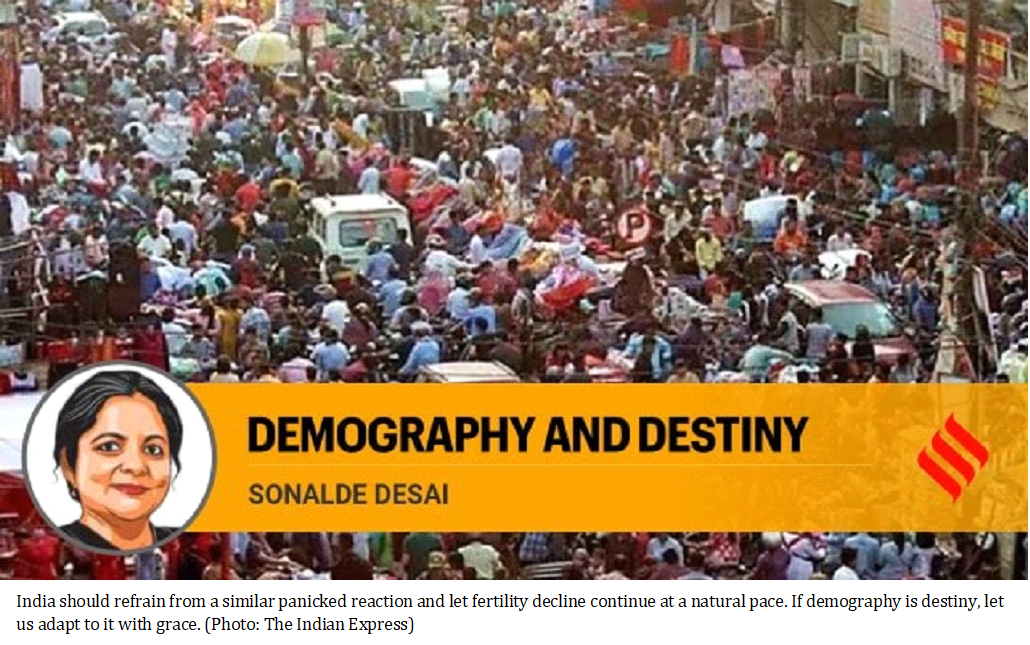Population growth committee: Move beyond Emergency-era fears
06 Feb 2024
Opinion: Sonalde Desai.
The population dialogue in India has been dominated by concerns about population explosion. However, it is time for us to move these fears and learn from the experiences of other countries.
In her speech, while presenting the 2024 budget, Finance Minister Nirmala Sitharaman promised a committee to study India’s population growth to ensure that the nation is on target to meet the Viksit Bharat goal by 2047. Coming nearly 50 years after the brutal implementation of the population control programme in 1976, I hope this move reflects a shift in public discourse regarding the course of India’s demographic transformation.
India is and will remain the world’s most populous nation for the foreseeable future. Nonetheless, it does not appear to be the fearsome prospect it once appeared to be. Fertility has steadily declined to a level where two parents are being replaced by two children and all segments of the society have begun to adopt family planning.
Moreover, India has learned not to let the burden of a growing population pose an obstacle to its continued economic growth. However, we have yet to adapt to the changes that population transformation brings. I hope this committee will focus on reshaping the policy agenda that rides the inevitable demographic wave and not be mired in the old discourse of population bomb. This will require focusing on several priorities.
First, we must recognise that India’s demographic destiny for 2047 has already been written. The workforce of 2047 has already been born and will look very different from the workforce of 2024. Today 33 per cent of the population is aged 20-29, while 23 per cent of the population is aged 40-59. But in 2047, the proportion of the younger population will decrease, and the proportion of older working ages will increase, with each forming about 28 per cent of the population. To ensure that this growing proportion of middle-aged workers can keep up with the changing demands of an increasingly technologically driven economy, we must invest in continued skill upgradation and on-the-job training above and beyond formal education.
Second, all of India will not undergo demographic changes at the same pace. Just as fertility decline first emerged in southern, more developed states, population aging will also be most visible in these states. Dependency burden, defined as the number of individuals ages 15-59 supporting children under 15 and older population above 60, will vary dramatically between states. For example, demographer P.M. Kulkarni estimates that in 2021, in Bihar, 151 working-age adults supported 100 dependents, while in Tamil Nadu, 189 adults supported the same population; this will flip with the worker-to-dependent ratio changing to 201 in Bihar and 132 in Tamil Nadu by 2051.
In short, the future of India’s elderly and children will rest on workers’ productivity in states we have historically considered demographic laggards, such as Bihar, Uttar Pradesh, Madhya Pradesh, and Chhattisgarh. How can we invest in the workers in these states to ensure the future welfare of all Indians? This will be the challenge that the newly formed 16th Finance Commission will face as it decides on inter-state allocations.
Third, as fertility declines, the burden of child care for women drops. My analysis of National Family Health Survey data, undertaken with sociologist Sojin Yu, shows that in 1993, an average woman spent about 14 years caring for children under age five, while that number dropped to eight years in 2021. However, time freed up from childcare has not been utilised in increased participation in the workforce.
Unless we find ways of creating a welcoming labour market for women, we will waste the opportunity of turning a demographic dividend into a gender dividend. One of the best ways of expanding women’s ability to participate in the job market may be to improve the availability of childcare, possibly through creative combinations of Anganwadi and the Mahatma Gandhi National Rural Employment Guarantee Scheme. There is no reason why permissible MGNREGA works cannot include rotational provision of childcare under the supervision of a trained early childhood educator.
Fourth, a combination of rising numbers of elderly and a declining number of children to care for them means we must increase the ability of this older population to be self-sustaining. A combination of policies will be needed, including rising retirement age, enhanced old age pension schemes, and increased ability to sell land or homes, assets in which most of the wealth of the Indian elderly resides.
Historically, the population dialogue in India has been dominated by concerns about population explosion. However, it is time for us to move beyond the Emergency era fears and learn from the experiences of other countries. In its quest for rapid population control, China implemented a strict one-child policy, bringing it to a demographic cliff where the needs of its aging population have begun to drag down its economic growth. Relaxing the one-child limitation has been unsuccessful in increasing fertility. This suggests that India should refrain from a similar panicked reaction and let fertility decline continue at a natural pace. If demography is destiny, let us adapt to it with grace.
These complex challenges require multifaceted attention from demographers, economists, sociologists, and public policy experts. The move to set up a high-powered committee to evaluate the challenges posed by demographic transformation in conjunction with the 16th Finance Commission will allow its recommendations to flow into government spending priorities, creating a virtuous cycle.
The writer is professor at the University of Maryland and the National Council of Applied Economic Research. Views are personal
Published in: The Indian Express, 06 Feb 2024






